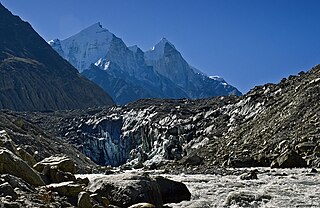
Gangotri is located in Uttarkashi District, Uttarakhand, India in a region bordering Tibet. This glacier, one of the primary sources of the Ganges, has a volume of over 27 cubic kilometers. The glacier is about 30 kilometres long and 2 to 4 km wide. Around the glacier are the peaks of the Gangotri Group, including several peaks notable for extremely challenging climbing routes, such as Shivling, Thalay Sagar, Meru, and Bhagirathi III. It flows roughly northwest, originating in a cirque below Chaukhamba, the highest peak of the group.
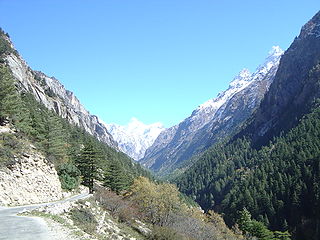
Gangotri is a town and a Nagar Panchayat (municipality) in Uttarkashi district in the state of Uttarakhand, India. It is 99 km from Uttarkashi, the main district headquarter. It is a Hindu pilgrim town on the banks of the river Bhagirathi – the origin of the river Ganges. The town is located on the Greater Himalayan Range, at a height of 3,100 metres (10,200 ft). According to a popular Hindu legend, the goddess Ganga descended here when Shiva released the mighty river from the locks of his hair.
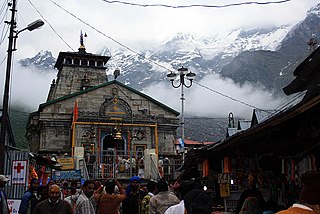
Garhwal is one of the two administrative divisions of the Indian state of Uttarakhand. Lying in the Himalayas, it is bounded on the north by Tibet, on the east by Kumaon, on the south by Uttar Pradesh state, and on the northwest by Himachal Pradesh state. It includes the districts of Chamoli, Dehradun, Haridwar, Pauri Garhwal, Rudraprayag, Tehri Garhwal, and Uttarkashi. The people of Garhwal are known as Garhwali and speak the Garhwali language. The administrative center for Garhwal division is the town of Pauri. The Divisional Commissioner is the administrative head of the Division, and is a senior Indian Administrative Service officer. As the administrative head of the division, the Commissioner is overall incharge of the 7 districts in the Garhwal region of Uttarakhand, and is aided in his duties by an additional commissioner and the district magistrates. Sushil Kumar is the divisional commissioner of the Garhwal Division since December 2021.
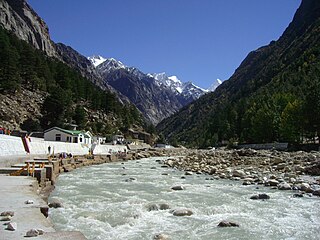
The Bhāgīrathī is a turbulent Himalayan river in the Indian state of Uttarakhand, and one of the two headstreams of the Ganges, the major river of Northern India and the holy river of Hinduism. In the Hindu faith, history, and culture, the Bhagirathi is considered the source stream of the Ganges. However, in hydrology, the other headstream Alaknanda, is considered the source stream on account of its great length and discharge. The Bhagirathi and Alaknanda join at Devprayag in Garhwal and are thereafter known as the Ganges.

Yamunotri, also Jamnotri, is the source of the Yamuna River and the seat of the Goddess Yamuna in Hinduism. It is situated at an altitude of 3,293 metres (10,804 ft) in the Garhwal Himalayas and located approximately 150 kilometres (93 mi) North of Uttarkashi, the headquarters of the Uttarkashi district in the Garhwal Division of Uttarakhand, India. It is one of the four sites in India's Chota Char Dham pilgrimage. The sacred shrine of Yamunotri, source of the river Yamuna, is the westernmost shrine in the Garhwal Himalayas, perched atop a flank of the Bandarpunch mountain. The chief attraction at Yamunotri is the temple devoted to the Goddess Yamuna and the holy thermal springs at Janki Chatti which is 7 km away.
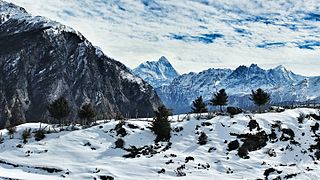
Uttarakhand, formerly known as Uttaranchal, is a state in northern India. The state is divided into two divisions, Garhwal and Kumaon, with a total of 13 districts. The winter capital and largest city of the state is Dehradun, which is also a railhead. On 5 March 2020, Bhararisain, a town in the Gairsain Tehsil of the Chamoli district, was declared as the summer capital of Uttarakhand. The High Court of the state is located in Nainital, but is to be moved to Haldwani in future.
The Chota Char Dham is an important Hindu pilgrimage circuit in Uttarakhand, in the Indian Himalayas. Located in the Garhwal region of the state of Uttarakhand, the circuit consists of four sites—Gangotri, Yamunotri, Kedarnath, and Badrinath. Badrinath is also one of the four destinations of the longer Char Dham from which the Chota Char Dham likely draws its name.

Uttarkashi District is a district of Garhwal division of the Uttarakhand state in northern India, and has its headquarters at Uttarkashi city. It has six Tehsils namely Barkot, Dunda, Bhatwadi, Chinyalisaur, Purola and Mori.

Uttarkashi, meaning Kashi of the north, is a town located in Uttarkashi district in Uttarakhand, India. Uttarkashi town is headquarters of the district. Uttarkashi is also known as Somya Kashi. Uttarkashi is a Hindu religious place for spiritual and adventurous tourism. Uttarkashi town is also called as Shivnagri. The town has number of temples and ashrams. Uttarkashi is known for its religious people, weather, education.

The Garhwal Himalayas are mountain ranges located in the Indian state of Uttarakhand.

Yamunotri Temple is situated in the western region of Garhwal Himalayas at an altitude of 3,291 metres (10,797 ft) in Uttarkashi district, Uttarakhand. It's just 129 km from Uttarkashi, the main district headquarters. The temple is dedicated to Goddess Yamuna, and has a black marble idol of the goddess. The Yamunotri temple is a full day's journey from Uttarakhand's main towns — Uttarkashi, Rishikesh, Haridwar or Dehradun.
The Jad people are a semi nomadic tribe living in great Himalayas in Himachal Pradesh and Uttarakhand states of India. They are primarily settled in the bordering region of Uttarakhand, Himachal Pradesh and Tibet. They mainly practiced sheep rearing and were shrewd traders trading with the Tibet. They were also recognised as the rulers of the Gartang Garh. The famous tourist destination Gartang Gali is also found near their village. They were entrusted by the King of Garhwal, with the important strategic task of securing the borders of Garhwal Kingdom from the Bushahr kingdom of Himachal and the Tibetan Empire. The language they speak is critically endangered almost endemic to India. Although, the language share some similarity to the kinnauri and spiti language which also Is of Tibeto-Burman family.

Pulam Sumda is a small hilly village which lies in Uttarkashi District, Uttarakhand, India.

Nelang or Nilang is a river valley of the Himalayas, containing a small eponymous village, in the Uttarkashi District of the state of Uttarakhand, India. It is close to the disputed Sino-Indian Line of Actual Control (LAC), and is also claimed by China as part of Zanda County of Ngari Prefecture of Tibet.
The Lamkhaga Pass is one of the toughest pass which connects Kinnaur district of Himachal Pradesh with Harshil in Uttarakhand. Harsil-Kharcham Highway will have a Lamkhaga Pass tunnel, and the highway route will also connect to Char Dham Highway and Pooh-Chumar-Hanle Highway.
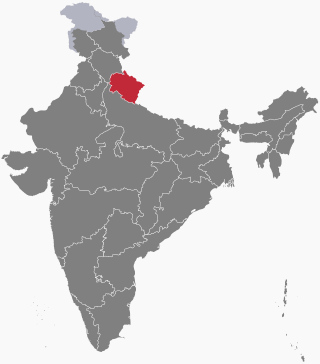
The following outline is provided as an overview of and topical guide to Uttarakhand:

Char Dham National Highway, is an under construction two-lane 889 km long National Highway with a minimum width of 10 metres in the Indian state of Uttarakhand under Char Dham Pariyojana. The under construction highway will complement the under-construction Char Dham Railway by connecting the four holy places in Uttarakhand states namely Badrinath, Kedarnath, Gangotri and Yamunotri. The project includes 889 km national highways which will connect the whole of Uttarakhand state. It will connect Delhi–Dehradun Expressway on its southern end to India-China Border Roads on its northern ends.
The Char Dham Railway, the Indian Railways's under construction twin railway lines under Char Dham Pariyojana project by connecting the holiest places of Hinduism called Chota Char Dham, from the existing Doiwala railway station near Dehradun to Gangotri and Yamunotri via a fork at Uttarkashi and another set of twin rail links from the upcoming railway station at Karnaprayag to Kedarnath and Badrinath via a fork at Saikot. The line is also of strategic military importance and has been designated a national project.
The Rishikesh–Karnaprayag line is an under-construction railway line, which will run from Yog Nagari Rishikesh railway station in Rishikesh to Karnaprayag. It is Indian Railways' proposed route for the Char Dham Railway to connect the Char Dham pilgrimage of Uttarakhand. The line is also part of an Indian geostrategic initiative to build infrastructure along the India-China border to discourage Chinese expansion. The project is considered to be of national strategic importance and is being tracked on the Central Government’s PRAGATI portal. When ready, it will help improve connectivity to the Char Dham shrines of Yamunotri, Gangotri, Badrinath and Kedarnath in the Garhwal region of the Himalayas in Uttarakhand.
The Defence Institute of Bio-Energy Research (DIBER) is an Indian defence laboratory of the Defence Research and Development Organisation (DRDO), located in Haldwani in Uttarakhand state. It conducts research and development of bioenergy as well as the sustainable and eco-friendly high altitude agro-technologies in the Indian Himalayan Region for the use of Indian Military. It has developed a range of vegetable varieties suitable for mid to high altitude.
















